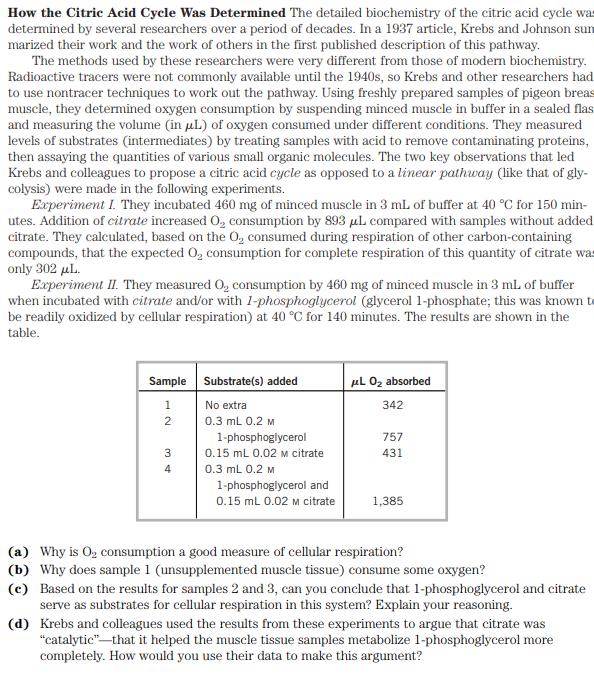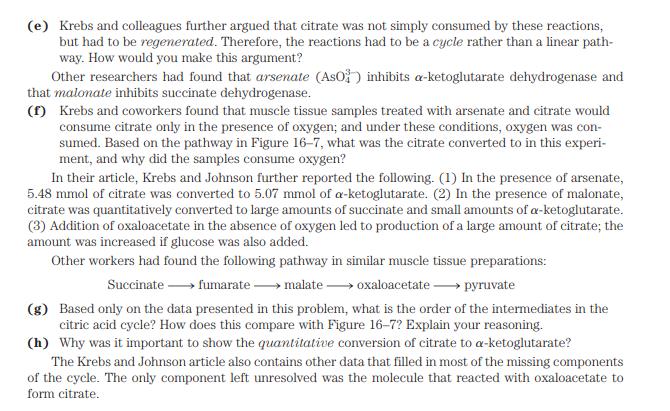Answered step by step
Verified Expert Solution
Question
1 Approved Answer
How the Citric Acid Cycle Was Determined The detailed biochemistry of the citric acid cycle was determined by several researchers over a period of


How the Citric Acid Cycle Was Determined The detailed biochemistry of the citric acid cycle was determined by several researchers over a period of decades. In a 1937 article, Krebs and Johnson sun marized their work and the work of others in the first published description of this pathway. The methods used by these researchers were very different from those of modern biochemistry. Radioactive tracers were not commonly available until the 1940s, so Krebs and other researchers had to use nontracer techniques to work out the pathway. Using freshly prepared samples of pigeon breas muscle, they determined oxygen consumption by suspending minced muscle in buffer in a sealed flas and measuring the volume (in L) of oxygen consumed under different conditions. They measured levels of substrates (intermediates) by treating samples with acid to remove contaminating proteins, then assaying the quantities of various small organic molecules. The two key observations that led Krebs and colleagues to propose a citric acid cycle as opposed to a linear pathway (like that of gly- colysis) were made in the following experiments. Experiment I. They incubated 460 mg of minced muscle in 3 mL of buffer at 40 C for 150 min- utes. Addition of citrate increased O, consumption by 893 L compared with samples without added. citrate. They calculated, based on the O consumed during respiration of other carbon-containing compounds, that the expected O consumption for complete respiration of this quantity of citrate was only 302 L. Experiment II. They measured O consumption by 460 mg of minced muscle in 3 mL of buffer when incubated with citrate and/or with 1-phosphoglycerol (glycerol 1-phosphate; this was known to be readily oxidized by cellular respiration) at 40 C for 140 minutes. The results are shown in the table. Sample Substrate(s) added 1 2 3 4 No extra 0.3 mL 0.2 M 1-phosphoglycerol 0.15 mL 0.02 M citrate 0.3 mL 0.2 M 1-phosphoglycerol and 0.15 mL 0.02 M citrate L O absorbed 342 757 431 1,385 (a) Why is O consumption a good measure of cellular respiration? (b) Why does sample 1 (unsupplemented muscle tissue) consume some oxygen? (c) Based on the results for samples 2 and 3, can you conclude that 1-phosphoglycerol and citrate serve as substrates for cellular respiration in this system? Explain your reasoning. (d) Krebs and colleagues used the results from these experiments to argue that citrate was "catalytic" that it helped the muscle tissue samples metabolize 1-phosphoglycerol more completely. How would you use their data to make this argument? (e) Krebs and colleagues further argued that citrate was not simply consumed by these reactions, but had to be regenerated. Therefore, the reactions had to be a cycle rather than a linear path- way. How would you make this argument? Other researchers had found that arsenate (ASO) inhibits a-ketoglutarate dehydrogenase and that malonate inhibits succinate dehydrogenase. (f) Krebs and coworkers found that muscle tissue samples treated with arsenate and citrate would consume citrate only in the presence of oxygen; and under these conditions, oxygen was con- sumed. Based on the pathway in Figure 16-7, what was the citrate converted to in this experi- ment, and why did the samples consume oxygen? In their article, Krebs and Johnson further reported the following. (1) In the presence of arsenate, 5.48 mmol of citrate was converted to 5.07 mmol of a-ketoglutarate. (2) In the presence of malonate, citrate was quantitatively converted to large amounts of succinate and small amounts of a-ketoglutarate. (3) Addition of oxaloacetate in the absence of oxygen led to production of a large amount of citrate; the amount was increased if glucose was also added. Other workers had found the following pathway in similar muscle tissue preparations: Succinate fumarate malateoxaloacetate pyruvate (g) Based only on the data presented in this problem, what is the order of the intermediates in the citric acid cycle? How does this compare with Figure 16-7? Explain your reasoning. (h) Why was it important to show the quantitative conversion of citrate to a-ketoglutarate? The Krebs and Johnson article also contains other data that filled in most of the missing components of the cycle. The only component left unresolved was the molecule that reacted with oxaloacetate to form citrate.
Step by Step Solution
★★★★★
3.46 Rating (162 Votes )
There are 3 Steps involved in it
Step: 1
The detailed ...
Get Instant Access to Expert-Tailored Solutions
See step-by-step solutions with expert insights and AI powered tools for academic success
Step: 2

Step: 3

Ace Your Homework with AI
Get the answers you need in no time with our AI-driven, step-by-step assistance
Get Started


